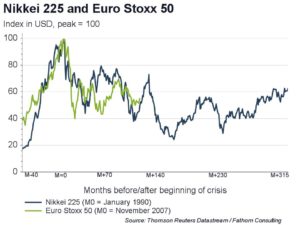A sideways look at economics
38915.9. To this day, that remains the Nikkei 225’s all-time high, reached on 29 December 1989. Since that time Japan has suffered the best part of three lost decades, with little or no growth, and little or no inflation. Japan’s woes were triggered by the bursting of its asset price bubble, which saw a collapse in both equity and land prices. Inevitably, non-performing loans (NPLs) rose sharply through the early 1990s.
Those who cannot remember the past are condemned to repeat it, according to George Santayana.
The euro area is repeating Japan’s experience, though it can hardly have failed to remember it. Europe has experienced a banking crisis much like that of Japan. Although the fall in property prices in Europe has been less dramatic, the collapse in equity prices through the financial crisis of 2008 / 2009 was similar, and the NPL ratio in Italy and Portugal exceeds that seen in Japan in the 1990s.
The response of Japan’s policymakers is best characterised as ‘too little, too late’. NPLs were not written down in earnest until the end of the 1990s, almost ten years after the trouble began. European policymakers have taken a similar path. It is a failure to fix Europe’s broken banking system that is holding the region back, preventing credit reaching those parts of the economy where it is needed most, undermining both growth and inflation.
To cheers from many, in local currency terms the Eurostoxx 50 reached its highest level in over a year earlier this week. It has now climbed more than 20% since the Brexit vote. Since Japan’s crisis hit in the late 1980s, the Nikkei 225 has experienced similar upturns in local currency terms. Indeed, it has rallied over the last year too. 19262.5. That is the level of the Nikkei 225 today. Despite the ebbs and flows over the years, Japan’s headline equity index remains some 50% below its all-time high.
What is worse, many of these ‘recoveries’ in equity prices have really just reflected currency movements. As our second chart shows, in US dollar terms the performance of the Eurostoxx 50 is alarmingly similar to that of the Nikkei 225. If history is repeating itself, in dollar terms, the Eurostoxx 50 is looking at another decade of see-sawing around a flat line.

